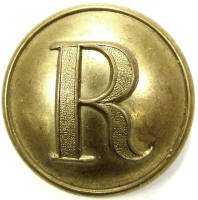
A virtual examination of artifacts of the American Civil War
 | Ridgeway Civil War Research Center,
A virtual examination of artifacts of the American Civil War |
| Civil War Artillery | |
| by Harry Ridgeway |
| Rifled artillery projectile, Britten design, English manufacture, bursting shell, pattern with short tapered nose segmented interior, lead cup sabot, threaded for unknown fuze, 10 pounder rifle, 2.9 in. or Ordnance rifle, 3in. Projectile was manufactured by the English and exported to the American conflict, either side could purchase them, but primary use was southern. The design follows Britten's English patent, employing a lead cup sabot with a counter bulge or large concave teat that extends beyond the bottom. There is a ring around the nose which probably was left from it being clamped to the lathe, American producers tended to use knobs. Interior is segmented to provide points of weakness for maximum fragmentation. It appears that the segmented interior, which is hardened steel, may have initially been manufactured as rolled sheet, then bent into a cylinder forming the core, then an iron skin cast onto the cylinder, the casting is very thin on the bottom covered only by the lead cup sabot. Fuze hole is left hand threaded British fuze, however all that have been recovered either were missing the fuze or the fuze was plugged with a wood shipping plug. There is some evidence that these shells were captured by the Federals from the Confederates and were simply fired as bolts due to the problem of them being separated from their fuzes. Projectile measures smaller than 2.9 in. suggesting that it may have originally been intended for the 10 pounder, however, the short length with a soft lead sabot would not have been suited at all for a 3 groove 10 pounder 2.9in. rifle, those missing the sabot may have been fired from this rifle, the torque from firing 3 groove would tend to rip the sabot away. All examples recovered with fired sabot remaining show 7 grooves suggesting most were actually fired from a 3 inch rifle, it would have fit loose in a 3 inch bore and this would account for the weak rifling. It is speculated that this pattern was originally manufactured for the smaller 2.9in. rifle, but most were used in the 3in. rifle as a practical solution. Projectile measures: diameter 2.86in., length 5.0in. (excluding fuze), weight 6.2lb. Research Center: Artillery3413-Britten, Ref: Dickey & George, Field Artillery (1993 Edition), pg. 110. Details click: http://relicman.com/artillery/Artillery3413-Britten.html. |
| Ridgeway Civil War Research Center, A virtual examination of artifacts of the American Civil War. Artillery Research center, artillery, click: http://relicman.com/artillery/Artillery0000-Index.html. Research center, artillery, click: http://relicman.com/artillery/Artillery0000-Index.html. |
| Civil War Relicman, Harry Ridgeway, Civil War artillery, Relicman sales catalog. Click here: http://relicman.com/artillery/RelicmanSalesArtillery1.html. Artillery for sale: http://relicman.com/artillery/RelicmanSalesArtillery1.html. |